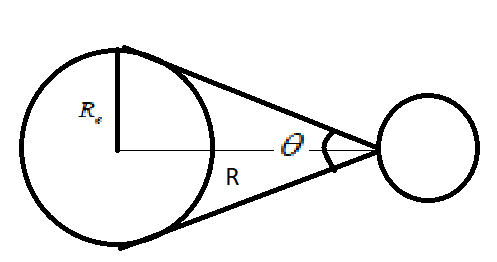
The solar constant for the earth is S. The surface temperature of the sun is \[{T_{}}K\]. The sun subtends an angle \[\theta \] at the earth
(A) \[S \propto {T^4}\]
(B) \[S \propto {T^2}\]
(C) \[S \propto {\theta ^2}\]
(D) \[S \propto \theta \]
Answer
133.5k+ views
Hint Let R be the distance between the center of earth and the surface of the sun and let \[{R_e}\]be the radius of the earth. Now, use the energy received per unit area on earth’s surface formula to find the relation.
Complete Step By Step Solution
Let us draw the given scenario in a simple diagram. The sun rays hit the earth across its center and tangent points. Let R be the distance between the surface of the sun and the centre of the earth. Now, \[{R_e}\] is the radius of the earth. The sun rays subtend an angle \[\theta \], with respect to R. The image is shown below:

Now, Solar energy received per unit area is defined as the amount of solar energy received over the earth’s surface from the sun. Solar constant is defined as the ratio between the power received from the sun and the square of the distance between sun and center of the earth. Mathematically, given as
\[S = \dfrac{P}{{4\pi {R^2}}}\]
Power radiated by the sun is mathematically given as
\[P = {A_s} \times \sigma {T^4}\], where A is area of the sun, T is temperature on the surface of the sun and \[\sigma \] is Stefan-Boltzmann constant
Substituting P on the above formula we get,
\[ \Rightarrow S = \dfrac{{4\pi {R_s}^2 \times \sigma {T^4}}}{{4\pi {R^2}}}\]
Cancelling out the common terms, we get,
\[ \Rightarrow S = \dfrac{{{R_s}^2 \times \sigma {T^4}}}{{{R^2}}}\]
\[ \Rightarrow S \propto {T^4}\]
Thus, Option (A) is the correct answer for the given question.
Note The power radiated by the sun is defined as the product of power density of the sun’s rays and the total surface area of the sun. Since the sun is a star, the Stefan-Boltzmann law applies, which describes the power radiated by a black body with respect to its temperature.
Complete Step By Step Solution
Let us draw the given scenario in a simple diagram. The sun rays hit the earth across its center and tangent points. Let R be the distance between the surface of the sun and the centre of the earth. Now, \[{R_e}\] is the radius of the earth. The sun rays subtend an angle \[\theta \], with respect to R. The image is shown below:

Now, Solar energy received per unit area is defined as the amount of solar energy received over the earth’s surface from the sun. Solar constant is defined as the ratio between the power received from the sun and the square of the distance between sun and center of the earth. Mathematically, given as
\[S = \dfrac{P}{{4\pi {R^2}}}\]
Power radiated by the sun is mathematically given as
\[P = {A_s} \times \sigma {T^4}\], where A is area of the sun, T is temperature on the surface of the sun and \[\sigma \] is Stefan-Boltzmann constant
Substituting P on the above formula we get,
\[ \Rightarrow S = \dfrac{{4\pi {R_s}^2 \times \sigma {T^4}}}{{4\pi {R^2}}}\]
Cancelling out the common terms, we get,
\[ \Rightarrow S = \dfrac{{{R_s}^2 \times \sigma {T^4}}}{{{R^2}}}\]
\[ \Rightarrow S \propto {T^4}\]
Thus, Option (A) is the correct answer for the given question.
Note The power radiated by the sun is defined as the product of power density of the sun’s rays and the total surface area of the sun. Since the sun is a star, the Stefan-Boltzmann law applies, which describes the power radiated by a black body with respect to its temperature.
Recently Updated Pages
JEE Main 2025 Session 2 Form Correction (Closed) – What Can Be Edited

Sign up for JEE Main 2025 Live Classes - Vedantu

JEE Main Books 2023-24: Best JEE Main Books for Physics, Chemistry and Maths

JEE Main 2023 April 13 Shift 1 Question Paper with Answer Key

JEE Main 2023 April 11 Shift 2 Question Paper with Answer Key

JEE Main 2023 April 10 Shift 2 Question Paper with Answer Key

Trending doubts
JEE Main 2025 Session 2: Application Form (Out), Exam Dates (Released), Eligibility, & More

JEE Main 2025: Conversion of Galvanometer Into Ammeter And Voltmeter in Physics

JEE Main 2025: Derivation of Equation of Trajectory in Physics

Electric Field Due to Uniformly Charged Ring for JEE Main 2025 - Formula and Derivation

Class 11 JEE Main Physics Mock Test 2025

Current Loop as Magnetic Dipole and Its Derivation for JEE

Other Pages
JEE Advanced Marks vs Ranks 2025: Understanding Category-wise Qualifying Marks and Previous Year Cut-offs

Units and Measurements Class 11 Notes: CBSE Physics Chapter 1

Important Questions for CBSE Class 11 Physics Chapter 1 - Units and Measurement

NCERT Solutions for Class 11 Physics Chapter 2 Motion In A Straight Line

Motion In A Plane: Line Class 11 Notes: CBSE Physics Chapter 3

Waves Class 11 Notes: CBSE Physics Chapter 14




